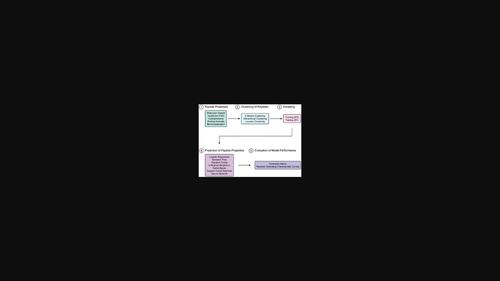当前位置:
X-MOL 学术
›
Adv. Theory Simul.
›
论文详情
Our official English website, www.x-mol.net, welcomes your feedback! (Note: you will need to create a separate account there.)
Machine Learning-Assisted Clustering of Nanoparticle-Binding Peptides and Prediction of Their Properties
Advanced Theory and Simulations ( IF 3.3 ) Pub Date : 2023-04-14 , DOI: 10.1002/adts.202300122 Kenry 1, 2
Advanced Theory and Simulations ( IF 3.3 ) Pub Date : 2023-04-14 , DOI: 10.1002/adts.202300122 Kenry 1, 2
Affiliation

|
Bioinspired and biomimetic nanostructures have attracted tremendous interest for theranostic and nanomedicine applications. Among the strategies employed to synthesize these nanostructures, surface functionalization and biomineralization of nanomaterials using peptides stand out due to the wide availability of peptides and their variations as well as the ease of modification process. Effective peptide-based modification of nanomaterials relies on preferential and strong binding between peptides and target nanomaterials. Therefore, the discovery and design of specific peptides with high binding affinity to nanomaterials are essential. Unfortunately, conventional peptide screening methods suffer from shortcomings which render peptide discovery time-consuming, expensive, and cumbersome. Herein, leveraging unsupervised and supervised machine learning, a framework to accelerate peptide analysis is presented. Specifically, more than 1700 nanoparticle-binding peptides are classified into peptide clusters to identify important peptide features to realize higher-affinity binding. In addition, the binding and biomineralization properties of peptides are predicted with high classification accuracy, precision, and recall. This work then proposes the use of unsupervised k-means clustering and supervised k-nearest neighbors algorithms for grouping peptides and predicting their properties, respectively. It is anticipated that the framework originated from this study will further facilitate the rational selection and design of peptides for engineering functional bioinspired and biomimetic nanostructures.
中文翻译:

机器学习辅助纳米颗粒结合肽的聚类及其特性预测
仿生纳米结构和仿生纳米结构引起了治疗诊断和纳米医学应用的极大兴趣。在用于合成这些纳米结构的策略中,由于肽及其变化的广泛可用性以及修饰过程的简便性,使用肽对纳米材料进行表面功能化和生物矿化显得尤为突出。纳米材料的有效的基于肽的修饰依赖于肽与目标纳米材料之间的优先且强的结合。因此,发现和设计与纳米材料具有高结合亲和力的特异性肽至关重要。不幸的是,传统的肽筛选方法存在缺点,导致肽的发现耗时、昂贵且繁琐。在此,利用无监督和监督机器学习,提出了加速肽分析的框架。具体而言,超过 1700 个纳米粒子结合肽被分类为肽簇,以识别重要的肽特征,以实现更高亲和力的结合。此外,以高分类准确度、精确度和召回率预测肽的结合和生物矿化特性。然后,这项工作提出使用无监督 k 均值聚类和有监督 k 近邻算法分别对肽进行分组并预测其属性。预计本研究的框架将进一步促进肽的合理选择和设计,用于工程功能性生物启发和仿生纳米结构。超过 1700 个纳米颗粒结合肽被分类为肽簇,以识别重要的肽特征,从而实现更高亲和力的结合。此外,以高分类准确度、精确度和召回率预测肽的结合和生物矿化特性。然后,这项工作提出使用无监督 k 均值聚类和有监督 k 近邻算法分别对肽进行分组并预测其属性。预计本研究的框架将进一步促进肽的合理选择和设计,用于工程功能性生物启发和仿生纳米结构。超过 1700 个纳米颗粒结合肽被分类为肽簇,以识别重要的肽特征,从而实现更高亲和力的结合。此外,以高分类准确度、精确度和召回率预测肽的结合和生物矿化特性。然后,这项工作提出使用无监督 k 均值聚类和有监督 k 近邻算法分别对肽进行分组并预测其属性。预计本研究的框架将进一步促进肽的合理选择和设计,用于工程功能性生物启发和仿生纳米结构。肽的结合和生物矿化特性的预测具有较高的分类准确度、精确度和召回率。然后,这项工作提出使用无监督 k 均值聚类和有监督 k 近邻算法分别对肽进行分组并预测其属性。预计本研究的框架将进一步促进肽的合理选择和设计,用于工程功能性生物启发和仿生纳米结构。肽的结合和生物矿化特性的预测具有较高的分类准确度、精确度和召回率。然后,这项工作提出使用无监督 k 均值聚类和有监督 k 近邻算法分别对肽进行分组并预测其属性。预计本研究的框架将进一步促进肽的合理选择和设计,用于工程功能性生物启发和仿生纳米结构。
更新日期:2023-04-14
中文翻译:

机器学习辅助纳米颗粒结合肽的聚类及其特性预测
仿生纳米结构和仿生纳米结构引起了治疗诊断和纳米医学应用的极大兴趣。在用于合成这些纳米结构的策略中,由于肽及其变化的广泛可用性以及修饰过程的简便性,使用肽对纳米材料进行表面功能化和生物矿化显得尤为突出。纳米材料的有效的基于肽的修饰依赖于肽与目标纳米材料之间的优先且强的结合。因此,发现和设计与纳米材料具有高结合亲和力的特异性肽至关重要。不幸的是,传统的肽筛选方法存在缺点,导致肽的发现耗时、昂贵且繁琐。在此,利用无监督和监督机器学习,提出了加速肽分析的框架。具体而言,超过 1700 个纳米粒子结合肽被分类为肽簇,以识别重要的肽特征,以实现更高亲和力的结合。此外,以高分类准确度、精确度和召回率预测肽的结合和生物矿化特性。然后,这项工作提出使用无监督 k 均值聚类和有监督 k 近邻算法分别对肽进行分组并预测其属性。预计本研究的框架将进一步促进肽的合理选择和设计,用于工程功能性生物启发和仿生纳米结构。超过 1700 个纳米颗粒结合肽被分类为肽簇,以识别重要的肽特征,从而实现更高亲和力的结合。此外,以高分类准确度、精确度和召回率预测肽的结合和生物矿化特性。然后,这项工作提出使用无监督 k 均值聚类和有监督 k 近邻算法分别对肽进行分组并预测其属性。预计本研究的框架将进一步促进肽的合理选择和设计,用于工程功能性生物启发和仿生纳米结构。超过 1700 个纳米颗粒结合肽被分类为肽簇,以识别重要的肽特征,从而实现更高亲和力的结合。此外,以高分类准确度、精确度和召回率预测肽的结合和生物矿化特性。然后,这项工作提出使用无监督 k 均值聚类和有监督 k 近邻算法分别对肽进行分组并预测其属性。预计本研究的框架将进一步促进肽的合理选择和设计,用于工程功能性生物启发和仿生纳米结构。肽的结合和生物矿化特性的预测具有较高的分类准确度、精确度和召回率。然后,这项工作提出使用无监督 k 均值聚类和有监督 k 近邻算法分别对肽进行分组并预测其属性。预计本研究的框架将进一步促进肽的合理选择和设计,用于工程功能性生物启发和仿生纳米结构。肽的结合和生物矿化特性的预测具有较高的分类准确度、精确度和召回率。然后,这项工作提出使用无监督 k 均值聚类和有监督 k 近邻算法分别对肽进行分组并预测其属性。预计本研究的框架将进一步促进肽的合理选择和设计,用于工程功能性生物启发和仿生纳米结构。



























 京公网安备 11010802027423号
京公网安备 11010802027423号